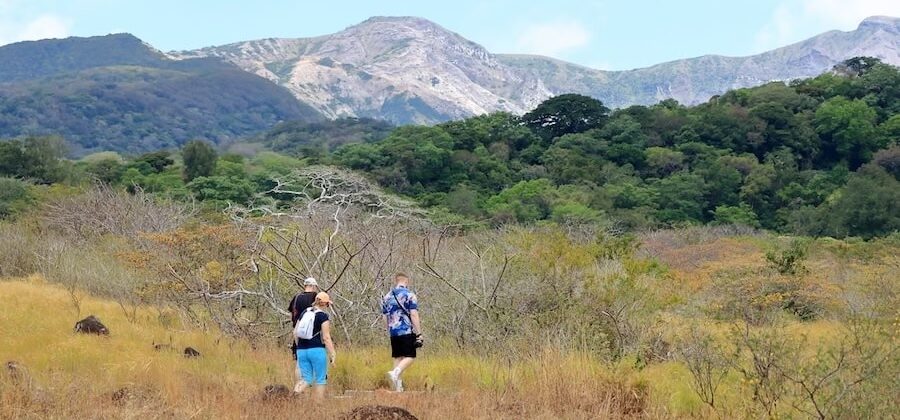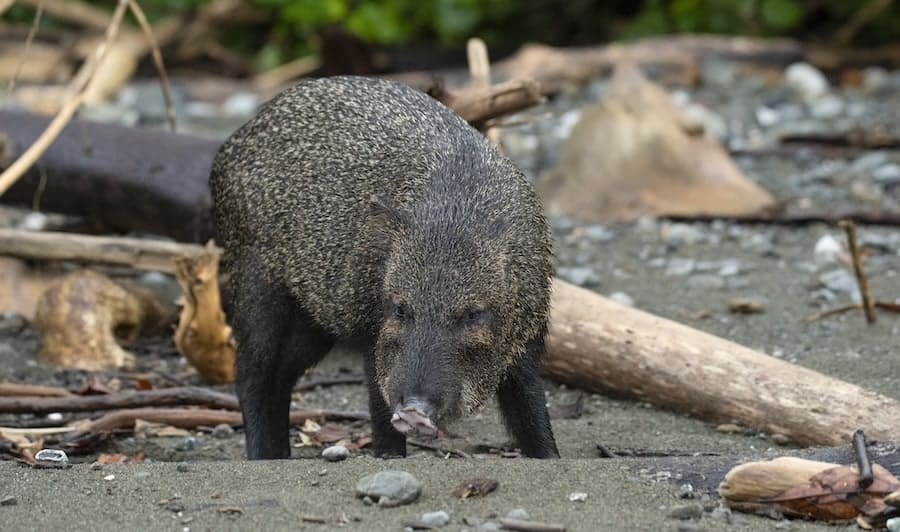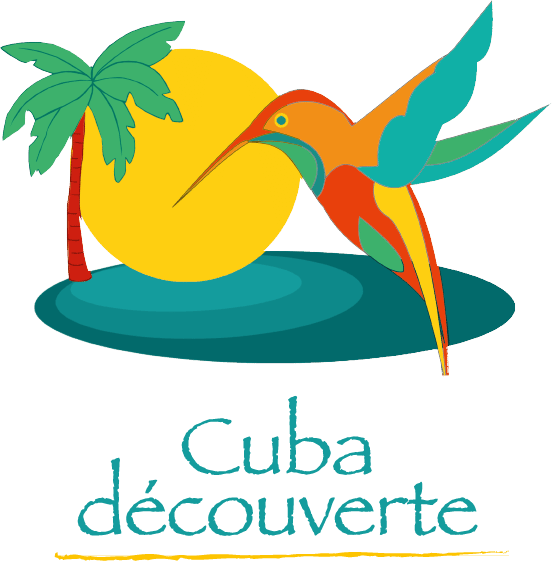Guanacaste National Park
Guanacaste National Park, a true jewel of Costa Rican biodiversity, covers a vast area of tropical dry forests, majestic volcanoes and wild coastline. This natural sanctuary is one of Costa Rica’s UNESCO World Heritage Parks, offering a unique insight into the ecological wealth of Central America.
It’s a relatively little-visited park in Costa Rica, despite its major interest, exciting hikes and biodiversity.
Geography of Guanacaste National Park
A mosaic of landscapes
Guanacaste National Park, located on the peninsula of the same name in Costa Rica, is a veritable mosaic of landscapes, the result of a complex geological history and a dry tropical climate. This geographical diversity is home to exceptional flora and fauna, making the park one of Costa Rica’s natural gems.
The park is bordered to the west by Santa Rosa National Park, giving it access to the sea, to the east by the foothills of the Cordillera de Guanacaste and to the south-west by Rincon de la Vieja National Park. This geographical location confers a wide diversity of microclimates and ecosystems. Its proximity to the North Pacific and immense beaches of black or white sand make it a wild and authentic stopover.
Varied relief and volcanic formation
The park’s relief is marked by the presence of two of Costa Rica’s major volcanoes: Orosí and Cacao. These extinct volcanoes have shaped the landscape, creating deep valleys, plateaus and steep slopes. Ancient lava flows have given rise to fertile soils, conducive to the development of lush vegetation.
Diverse Ecosystems
The park is home to a wide variety of ecosystems, each with its own characteristics:
- Tropical dry forests: the park’s dominant ecosystem. These forests, adapted to a dry climate, lose their leaves during the dry season to save water.
- Cloud forests: in the highest areas, cloud forests are characterized by high humidity and dense vegetation.
Hydrography
The park’s hydrographic network consists mainly of rivers and streams that flow into the Pacific Ocean. These watercourses play an essential role in supplying water to ecosystems and regulating the climate.
Dry tropical climate
The park’s climate is characterized by a long dry season and a shorter rainy season. Temperatures are high all year round, with little thermal variation. This climate has a direct influence on the park’s vegetation and wildlife.
The Guanacaste National Park is most interesting during the dry season. These different ecosystems are divided between tropical rainforest, cloud forest and tropical dry forest. The upper reaches of the park are dominated by the Orosi and Cacao volcanoes. It is important to note that between the hill and the Cacao Orosito volcano, the birth of rivers such as the Colorado which, in conjunction with other streams, form the Tempisque River, Guanacaste’s main watering hole.
A true natural reservoir, Guanacaste National Park preserves the largest herd of peccaries (Tayassu pécari) in the Guanacaste Conservation Zone. It is this biological corridor that enables the seasonal migration of a large number of insect, bird and mammal species down from Santa Rosa during the dry season to the high plateaus of the Orosi and Cacao volcanoes.
A journey to the heart of the tropical dry forest
- Geography and climate:
- Location: Nicoya Peninsula, Costa Rica
- Dry tropical climate and rainy season
- Varied terrain: volcanoes, plains, coastline.
- Dry forest:
- Adaptation of flora and fauna to drought
- Emblematic species: deciduous trees, cacti, lianas
- Ecological importance of these fragile ecosystems
The different sectors
Guanacaste National Park, a true jewel of Costa Rican biodiversity, is divided into three main sectors, each offering unique landscapes and ecosystems. Entrance is via the adjacent Santa Rosa Park. The price of $15 gives access to both parks on the same day.
Cocoa sector
Steep terrain through transitions of tropical dry forest, lowlands and the cloud forest of the Cacao volcano. Trails lead through the forest to the summit. The Pedregal hill station offers panoramic views of the Costa Rican countryside.
Pitrilla Sector
One of the least explored areas, two hiking trails wind through the rainforest. Magnificent views over Lake Nicaragua. Easy birdwatching.
Maritza Sector
This section of the park protects the upper reaches of the river. Scientific studies are carried out mainly on the area’s insects. Archaeology is also in the spotlight, as hundreds of pre-Columbian petroglyphs (rock engravings) can be seen here.
The main differences between these three sectors lie in:
- Altitude: the Cacao sector is the highest, followed by the Maritza sector and finally the Pitilla sector.
- Vegetation: vegetation varies according to altitude and sun exposure.
- Fauna: each sector is home to specific animal species, although some species are common to all three.
- Activities on offer: the activities on offer vary according to the infrastructure and trails available in each sector.the main differences between these three sectors lie in
Hikes
Costa Rica’s Guanacaste National Park offers a multitude of hiking trails for all levels, allowing you to explore the diversity of its landscapes. From short, easy routes through dry forest to longer, more demanding hikes leading to volcano peaks, you’re bound to find an itinerary to suit your taste. The region’s trails offer unique experiences for observing a rich and varied fauna, admiring spectacular panoramas and discovering the diversity of the local flora. Don’t forget good hiking boots, plenty of water and sunscreen.
The flora
The flora of Guanacaste National Park: a splash of green in the heart of Costa Rica
A veritable sanctuary of biodiversity, Guanacaste National Park is home to an exceptionally rich flora, shaped by a dry tropical climate and a complex geological history. This vegetation, adapted to local conditions, offers a striking visual spectacle and plays an essential role in the balance of this ecosystem. Visitors are often surprised to discover so many species during their visit.
Remarkable floral diversity
Guanacaste National Park is characterized by a great diversity of plant formations, ranging from tropical dry forests to cloud forests, mangroves and coastal zones. This diversity is due to several factors:
- Climate: the dry tropical climate, marked by a pronounced rainy and dry season, has a strong influence on vegetation composition.
- Topography: variations in altitude, the presence of volcanoes and steep slopes create a variety of microclimates, favoring the development of different plant species.
- Soils: soil type, nutrient content and drainage also influence vegetation distribution.
Emblematic species
The park’s most emblematic plant species include:
- Guanacaste (Enterolobium cyclocarpum): this majestic tree, which gives its name to the park, is recognizable by its large, wagon-wheel-shaped pods. It is often considered a national symbol of Costa Rica.
- Pochote (Ceiba pentandra): this giant tree, with its impressive tabular roots, can reach dizzying heights. It is generally used by birds for nesting.
- Tempisque (Spondias mombin): this drought-resistant tree produces edible fruit that is much appreciated by local wildlife.
- Cacti: many species of cactus have found refuge in the driest areas of the park, where they have adapted to the arid conditions.
- Orchids: the park is home to a wide variety of orchids, some of which are endemic. These delicate, colorful flowers are usually found in the wettest areas.
Thanks to its size, geographical position and climate with both Caribbean and Pacific influences, the forest on the slopes of the Orosi and Cacao volcanoes is made up of epiphytes such as bromeliads and orchids, as well as a large number of ferns, Araceae and mosses.
In all: some 3,000 plant species. The dominant tree species are the Tule tree, Tempisque, cork oak, cherry and golden fruit.
To survive in a dry environment, the park’s plants have developed remarkable adaptations:
- Deciduous leaves: many species lose their leaves during the dry season to limit transpiration.
- Deep roots: roots penetrate deep into the soil to reach the water table.
- Succulent stems: some plants, like cacti, store water in their stems.
- Thorns: thorns protect plants from herbivores and reduce the surface area available for evaporation.
The dry forest, a fragile ecosystem
The tropical dry forest that dominates much of the park is one of the world’s most threatened ecosystems. Deforestation, climate change and fires are the main threats to this unique habitat.
The fauna
The park’s fauna is extremely varied, with around 140 species of mammal, over 300 birds, 100 amphibians and reptiles and more than 10,000 species of insect identified. The most common animals are monkeys, congos, armadillos, mice, pumas and black hawks, among others.
Impressive animal diversity
The fauna of Guanacaste National Park is characterized by a great diversity of species, adapted to different environments. These include:
- Mammals: the most emblematic mammals include the jaguar, puma, tapir, peccary, capuchin monkey, howler monkey, sloth and armadillo. These species play an essential role in the balance of the ecosystem.
- Birds: the park is home to over 300 species of bird, many of them endemic or migratory. Among the most remarkable are the quetzal, macaw, toucan, hummingbird and harpy eagle.
- Reptiles and amphibians: reptiles are also well represented in the park, with species such as the green iguana, American crocodile, land tortoises and various species of snake. Amphibians, such as frogs and salamanders, populate the wetlands.
- Insects: this national park is home to an incredible diversity of insects, from butterflies to ants and beetles. These insects play an essential role in pollination and the decomposition of organic matter.
Adaptations to life in the tropical dry forest
The fauna of Guanacaste has developed remarkable adaptations to survive in an environment marked by prolonged dry seasons:
- Migration: some species, such as migratory birds, leave the park during the dry season to find food and water elsewhere.
- Aestivation: some animals go into aestivation during the dry season, a state of dormancy similar to hibernation.
- Nocturnal behavior: many animals are more active at night to avoid the heat of the day.
- Varied diet: animals have developed diets adapted to the resources available, depending on the season.
Threats and conservation
Despite its richness, the wildlife of Guanacaste National Park faces numerous threats, including deforestation, poaching and the introduction of invasive species. Costa Rica spares no effort in its conservation efforts to protect this exceptional biodiversity, notably through the creation of protected areas and animal population monitoring and surveillance programs.
Our advice for visiting Guanacaste National Park
Among Costa Rica’s many protected areas and parks, we particularly recommend taking the services of a naturalist guide to discover the hidden treasures of this protected area. The sheer size of the park, and the often poorly signposted access routes, mean that unaccompanied visitors can get lost. What’s more, the wildlife is particularly discreet.
We offer you a tailor-made guided tour of Costa Rica to help you discover this authentic and atypical region.







No comment regarding « Guanacaste National Park »